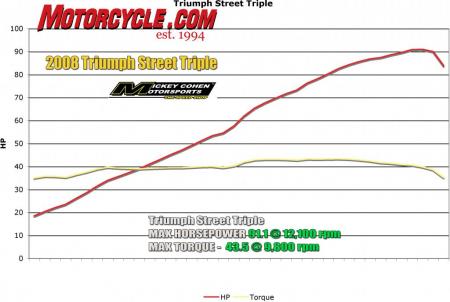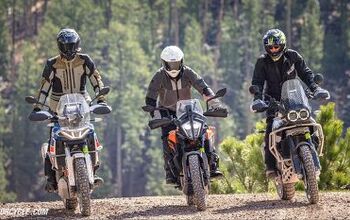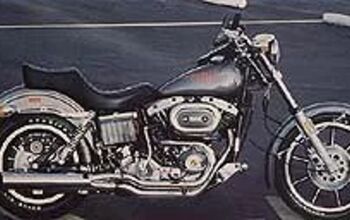Motorcycle.com

Get the Flash Player to see this player.
In a world seemingly filled with clones, its nice to have a choice. In a world full of Honda Accords and Civics, Toyota Camrys or Nissan Altimas, its nice to be able to throw the flat-Four or -Six of Subaru in the mix. With a McDonalds and Starbucks on every corner, having an independent neighborhood coffee house or an In-N-Out Burger joint can help break up the mundane and ubiquitous. And with all due respect to the talents and successes most pop singers, musicians and boy or girl bands enjoy, the atypical rhythmic stylings of the human tragedy that is Amy Winehouse provide a much-needed palate cleansing.Having choices beyond the usual offerings is good. If youre like us, then maybe you, too, like having variety, or seeking out the less popular. Boy, have we got a couple of machines for you! After having completed the individual reviews of each bike, but before turning them back to their owners, we put the 2008 Triumph Street Triple and 2008 Aprilia SL750 Shiver together for a little tte--tte in what were calling our 2008 Naked Middleweights Comparison.
Playas, not hatas
Though theres no denying the massive success rightfully earned and enjoyed by the Big Four in what is commonly recognized as the Middleweight (aka Supersport) Class, we cant expect every person with a motorcycle endorsement on their license to be effervescent about a group of bikes that are so closely linked in performance they all share identical bore and stroke figures (No kiddin! See our 2008 Supersport Shootout).
Three years ago, status quo in Middleweight Land got a shakeup when Triumph unleashed the Daytona 675 with its potent in-line Triple. The Four Horsemen of the Supersports didnt suffer any losses on the track, as the Daytona was virtually non-existent in AMA Formula Xtreme (the only class it was eligible for in AMA) roadrace competition during the past three years. However, they did see the Daytona become the darling of the motorcycle media.
In a somewhat predictable move, likely based on the long-running success of the English companys other naked, the Speed Triple, Triumph last year presented the world with the Street Triple 675. The nude three-cylinder hooligan is essentially an unfaired streetfighter version of the Daytona 675. Though it lacks many of the more premium components found on its racier mate, and doesnt achieve 100 hp or more at the rear wheel, the stripped-down Street and its ultra-usable powerband is still a formidable rival to the CBR600RR, ZX-6R, GSX-R600 and R6 where posted speed limits, stop signs and intersections are found.
E-I-C Duke recently tested the 2008 Aprilia SL750 Shiver. This 90-degree 749.9cc Twin is about as far from the norm as you can get without spending twice the Shivers MSRP to achieve such mold-breaking status.
The bike is loaded with high-tech bits such as true throttle-by-wire, a first in mass-produced motorcycles, according to Aprilia. Additionally, the bike has three power mappings available at the push of a button. Not unlike the A-B-C of Suzukis S-DMS (Suzuki-Drive Mode Selector), the Shivers mapping selections take away the guesswork of wondering what mode you should be in by labeling them Sport, Tour and Rain. Data transmitted to and through the robust gauge package that acts as a diagnostic center is carried by a mere two wires through whats called a Controlled Area Network, or CAN.
Along with the computer age found on the Aprilia, you also get quirky Italian styling, an exhaust note with the same degree of uniqueness as that of the raspy Triple and plenty of attention to detail in the Shivers fit and finish.
The SL750 might be the perfect antidote to the 600cc sportbike, Kevin says with conviction. He states pointedly that virtually all of the supersports flying off showroom floors, rarely, if ever, see time on a closed circuit course. Furthermore, he notes that the SLs strong low-rpm power and comfy, sensible ergos dont come at the cost of having the stigma of a lowly budget bike.
Five cylinders of fun!
Both bikes have chassis comprised of components that can be found readily on any number of other sporting machines these days. Yet, its the engines that establish the basic character of each of these scoots. The engines of each will be a point of primary consideration by many riders, simply because the Street Triple and Shiver are not part of the establishment, when determining whether or not to deem either bike worthy of ownership. These bikes are very much not in the mainstream.
The Triple is powered by a mill nearly identical to that of is sportbike brother, running the same bore and stroke of 74 x 52.3mm and 12.6:1 compression ratio as the Daytona. But in the case of the Street Triple the powerplant is made even more accessible and user-friendly for street duty by way of reduced valve lift and overlap on both intake and exhaust cams. Dyno results showed peak torque of 43.5 ft-lbs at 9800 rpm and a max of 91.1 hp at 12,100 rpm. In our Supersport Shootout this year, the Daytona 675 twisted out nearly 48 ft-lbs at 10,200 rpm with 106.5 hp at 12,500 rpm. With the Streets super-flat torque curve appearing so early in the rev range and maintaining peak or near peak for so long, on public roads the few foot-pounds deficit to the Daytona is nearly imperceptible.
I found fueling to be trouble-free on the Street Triple, but Kevin remarked that its throttle can be slightly abrupt upon reapplication. Combine that little nuance with the Triumphs quicker-revving engine and Kevin feels that the Triple is a bike more for expert riders. If you consider yourself more expert and less newbie, know then that the Street wheelies with utter confidence and ease. The Street Triple is the obvious hooligan, proclaims the Duke, adding that its eagerness to respond to all your inputs, whether theyre from your right wrist or your hands on the handlebar when tipping it in to a corner, is what helps make the Triumph such a fun little troublemaker.
The Aprilia compresses fuel mixture at a ratio of 11.0:1 in its twin cylinders, each with a 92 x 56.4mm bore and stroke. Inhaling and exhaling is through a total of eight valves actuated by chain- and gear-driven dual-overhead-cams. This cool Shiver offers good stonk as you might expect from a healthy-sized Vee, providing twist in excess of 39 ft-lbs available from as low as 3800 rpm all the way to redline, peaking at 7600 revs with 45.0 ft-lbs. Theres a price to pay for this great pull so far down. It feels peppy all the way to that 7600 mark but the giggles end soon as peak power of 76 hp arrives quickly at 9300 rpm. Those readings are down a full 20 and 25% from Aprilias claimed figures measured at the crank. Kevin edifies us with the knowledge that typical losses should be in the 10 to 14% range for a bike with chain final drive. We were left to wonder if perhaps something was slightly amiss with the Shivers state-of-tune.
For posterity, and then for what became more of a chuckle, we were curious to see what kind of power the Shiver made in Rain mode on the selectable mapping settings. All of 62.5 horsies rode in at 9500 rpm. The Tour mode results in essentially identical dyno results as when in the full-power Sport mode, but Tour provides for smoother throttle transitions, says Kevin, compared to the full blitz of Sport.
My time fiddling with the power mappings reflected as much, yet I could still squeeze out a wheelie with a little finessing of the clutch in the Tour setting. The manageable and tractable power of this Twin is an asset both in tight canyon turns and for overtaking slow-moving cagers. In Sport mode, I found the Aprilias closed-to-open throttle transition snatchy and downright bothersome at times. Duke sized up the Italian saying, its engine is not nearly as explosive as the TST, but it has a stronger and more linear midrange that makes for a ready-to-romp street powerplant.
Transmissions on each bike operated like a transmission in this day and age should: nearly perfect. We say nearly because a couple of false Neutrals slipped past us on the Shiver, otherwise all went swimmingly.
Weighty issues
Neither of these motorsickles is feathery, but it seems one has it over the other quite handily on the scales. The Street, stripped and simple compared to the Daytona, still manages to gain 4 lbs of claimed dry weight over its sibling, coming in at 367 lbs. That alone is a huge advantage when taken at face value as measured against the Aprilias claimed dry weight of 416 lbs. But, its what Aprilia obviously isnt saying that may be the heavier issue. According to our esteemed contemporaries over at Cycle World, the Shiver weighed in at a chunky 470 lbs with its tank empty, a full 77 lbs more than the Street was measured.
Another contributor to each bikes handling is the upright riding positions afforded by what are wide, motocross-style bars that provide a good deal of steering leverage. But the bars are part of a bigger picture: rider ergos. The rider triangle, as I like to refer to it, is where a greater chasm was found between this open-air pair.
The rider feels near bolt upright aboard the Shiver. Theres more room between its footpegs and saddle thats infinitely more comfortable than the Streets thinly-padded seat. I felt centered over the seat on the Aprilia where on the Triumph I tended to slide to toward the fuel tank, right where that thin padding was. This experience is attributable to the more aggressive peg-to-seat-to-bar relation on the Street. The Streets pegs, though lower and more forward than on the Daytona, are still further back and higher compared to the Shivers. Despite this softer position on the Shiver, we found it difficult to drag a peg. This is likely due to its taller ride height that equates to a 32-inch seat versus the flat-footing 31.6-inch height of the Triple.
Braking, at least in name, is another area where a big gap exists. The tony Shiver reels in speed with a set of radial-mount four-piston Brembo calipers up front crunching down on the same 320mm discs used on its relatives, the Aprilia Mille and Tuono. But despite braided steel lines, we were disappointed with excessive lever travel before actuating, and when they did, they bit with slight abruptness.
Quite the opposite of premium, or at least appearing to be premium, the Street reveals some of its budget ways with a pair of two-piston sliding-pin binders up front. When the phrase, radial-mount is bandied about with near recklessness these days, the Street is living in the past. Squeezed often enough under assertive riding, the brakes will suffer some fade despite stainless-steel lines and what is supposed to be the same pad material used on the Daytona. Ultimately, theyre sufficient, but the more precise feel and extra stopping power of commonly used four-pot binders would be nice.
Both motorcycles seemed to have missed the mark with respect to suspension choices. The Streets Kayaba fork, although 41mm and inverted, is entirely un-adjustable, and the Kayaba shock is good for pre-load adjustments only. However, the twin locking-rings could be adjusted from across the room as the top of the shock is incredibly accessible. Riding the Triumph is enjoyable over mostly smooth road surfaces. The bike remains stable while cornering, but crummy pavement starts to reveal poor damping up front. High-speed (i.e. sharp-angled) bumps result in a bit of a jarring ride; consistently rough roads also become less-than-fun thanks to the simplistic shock.
A 43mm inverted fork looks good on the Shiver, but it offers no adjustments. On the plus side, both triple clamps are made from forged (rather than cast) aluminum, and the unit actually does an adequate job overall. The rear shock is slightly less worthy, as it sucks up bumps without the benefit of a linkage. It has provisions for preload and rebound adjustments, but it seems over-sprung or under-rebounded for lighter riders. An additional observation was how the Shivers fueling seemed to exacerbate fore and aft pitching from the unbalanced suspension.
Despite any bias that Kevin or I may have exhibited toward one bike or the other, one thing we both agree on is how much more sensible each of these bikes are in the work-a-day world. Yet they dont sacrifice an ounce of entertainment value. On the street, or in the canyons, both the Shiver and Street Triple are capable of at least 90% of what more narrowly focused machines can do.
Theres no quibbling amongst us about the Aprilias excellent fit and finish, attention to detail (adjustable foot controls, for example), unusual but tasteful styling, and lest we forget, a very advanced electronics package with throttle-by-wire, a detailed LCD readout and selectable fuel mapping. The SL750 Shiver has an MSRP of $8999, and on the surface seems the better value, but only recently, as the Triumph saw a $300 a price increase earlier this year thanks to tightening economies and rising costs of raw materials, bumping it from its original $7999 to $8299.
El Capitan Duke summarizes his thoughts by saying the Shiver is a multi-function sporting tool compared to the Triples narrower focus and higher fun factor.
The Street Triple may be simpler and less sophisticated, but its attitude is blatantly unabashed. It has more giddy-up and go, and at a minimum, an equal amount of character in the engine room. It offers quicker handling, weighs less and has rugged looks to back up its streetfighter heritage.
If youre not as concerned with frugality and have been hoping for up-speced versions of these bikes, youre in luck. Well be looking to take a ride very soon on the 2009 Triumph Street Triple R that will now have the fully adjustable fork and radial-mount calipers found on the Daytona. Precisely the fix I was hoping for as I lamented those very components in our single bike review of the Street. Glad someone listens to me.
And Duke informs us that Aprilia was thinking ahead when making the Shiver: Aprilia has built some beef into its 750, as its chassis and crankcases will accommodate a 1200cc powerplant in an upcoming bigger brother we will see this fall.
Well, whaddya know? In our quest to look for an alternative to the same old same old, we seem to have muddy up the waters further by making choosing even an alternative difficult.
Related Reading:
2008 Triumph Street Triple 675 Review
2008 Aprilia SL750 Shiver Review
2008 Supersport Shootout
All Aprilia Reviews on Motorcycle.com
All Triumph Reviews on Motorcycle.com
All Standards Reviews on Motorcycle.com
Specs:
2008 Triumph Street Triple 675
2008 Aprilia SL 750 Shiver

Motorcycle.com presents an unrivaled combination of bike reviews and news written by industry experts
More by Motorcycle.com Staff





































Comments
Join the conversation